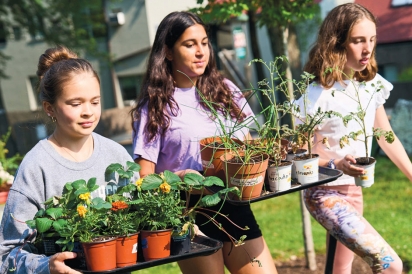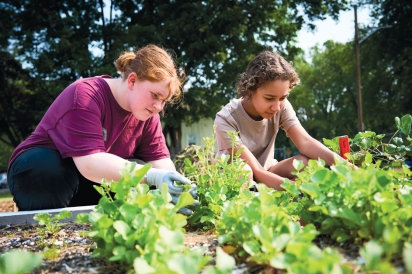Sowing the Seeds of Food Education
In the Garden and Classroom
In the edible gardens at Smithfield’s Raymond C. LaPerche Elementary School, preschoolers’ lettuce is a patchwork of assorted heads, while fifth graders planted symmetrical and color-coded rows. Kale, carrots, radishes and peas overflow the raised beds since students planted seeds by hand last spring. Then they water, harvest and snap off a pea shoot to snack on the fruits of their labor. Instruction continues in the cafeteria and the classroom here, too, as lunch menus and science classes incorporate local food and lessons on the value of growing your own.
These efforts are part of the district’s farm-to-school initiative to foster food education across disciplines in the Ocean State. Since eating food from local farms and planting food of your own teaches students so many lifelong lessons—like the value of farming, food literacy, healthy eating and plant life cycles—schools are doubling down on experiential learning opportunities to show children, rather than just tell them, the long-term importance of sustainable food.
“The schools here … are literally in the middle of farms. And yet the foods our kids were eating, or in some cases still are eating, are just really processed and not reflective of what is all around us,” says Smithfield Public Schools Assistant Superintendent Sara Monaco, who helped secure an $80,000 USDA Farm to School Grant that funded the district’s initiatives. “We built an action plan around the three Cs: community, cafeteria and classrooms. Then it completely evolved.”
From planting gardens in all the elementary schools, to revamping the foods program at the high school through an agricultural lens, to studying the whole food cycle and fostering student-led composting, Monaco says this actionable student engagement is all-encompassing and has reshaped their approach to education.
The students dig it too, says LaPerche Elementary School Principal Julie Dorsey. She raves that students light up when putting their hands in the soil, and when educator and Revive the Roots Manager Annie Bayer discusses the life cycle of garlic with them, students remember they planted it in spring and get to harvest it this fall.
“Kids plant some in their classrooms, and transfer to this garden, and want to do more,” Dorsey says, while surveying the raised beds. “Children can learn so much about community and empathy by gardening. They observe, slow down … then you splash in science and STEM curriculum … and they feel empowered to engage in this space and learn independently.”
Though they’re not growing enough food in the edible gardens to serve it at school meals, taste tests of their produce bridge the chasm between garden and classroom by allowing students to experiment and try new foods they might not see at home. As students devour smoothies full of hidden veggies, Dorsey marvels at their willingness to eat spinach and kale.
Further cementing that connection of the importance of fresh food, local farms contribute meats, produce and dairy to the school’s menus through Farm Fresh RI. Solange Morrissette, district manager for Chartwell’s, which is the town’s food service provider, says that while schools in Rhode Island serve many similar foods, Smithfield’s agricultural surroundings allow it to work closely with its farms, to foster strong community buy-in. Jaswell’s Farm and Steere Orchard in Smithfield are two farm-to-school partners, she says, and many additional farms grow specific produce and amounts to accommodate the schools’ needs.
“We do a lot of taste testings in our Discovery Kitchen, which is an educational program that teaches kids about nutrition facts of various items and then they taste in the cafeteria. We also have a Mood Boost program, which teaches kids about what foods affect which moods,” Morrissette says. “They can try a kale salad or something with blueberries in it because blueberries make you happy and kale makes you smart. So it’s really about engaging with the kids.”
REVIVING SCHOOL GARDENS
The Gordon School in East Providence also integrates food and sustainability into its infrastructure, with an extensive community garden system as well as an expanding curriculum and school-wide composting.
Cushman Gillen, the school’s fifth- and-sixth grade science teacher and new Green Dean, says they’re reinvigorating an edible schoolyard in a corner of the independent school’s 12-acre campus. Started by the middle school years ago, it was dilapidated and later abandoned, only to be adopted by the young kindergarten class. Eighth graders made their own garden designs in 2021 as a class project, and the school’s grounds committee and principal voted on the winning design, along with a budget for implementation.
“In our larger plan, we proposed a larger community garden that is a foundation for learning about regenerative agriculture,” Gillen says. “Everything from the ground up is edible, so we’re creating layers of food, from the ground to the canopy of leaves that intertwine.”
With teachers’ guidance, students built the raised boxes and bamboo fort at the entrance; devoted a space for composting; and dug down three feet to construct a hugelkulture, which is a permaculture method of creating garden beds by layering logs, sticks and compost that will retain moisture as it decays and slowly releases nutrients into the soil. While the raised beds are devoted to produce like corn, summer squash, tomatoes and peas, they’re also growing medicinal herbs and flowers to attract pollinating insects.
It’s all tied to the curriculum, too, and Gillen says they’re building on skills learned in the classroom. The garden connects with extended conversations about life cycles of caterpillars and praying mantises. They experiment with what compost works best, and third grade Spanish students grew a pico de gallo garden with onions, tomatoes and cilantro to connect with their language lessons.
Gillen says, “Our goal is to focus on zero hunger and clean water, what it takes to feed the world by making more nutritious food and teaching how underserved communities can enhance their own gardens.”
RHODE ISLAND FARM TO SCHOOL
When people think “farm to school,” often what comes to mind is serving fruits and vegetables and products from local farms. And Karin Wetherill of RI Healthy Schools Coalition says that’s clearly part of it. “But it’s also about how are kids being engaged in food literacy. It’s just so important that kids really understand where food comes from, and the impact of their food choices on their health, the environment and local economy,” she says. “If we want kids to eat healthy, if they can be involved in choosing what they’re eating, or if they grow a tomato and take care of that plant and nurture it, they are so much more likely to eat it.”
This fundamental concept was the genesis of the Rhode Island Farm to School Network, a statewide organization of leaders and community members founded in 2019 that unifies advocacy and organizational capacity to strengthen and enhance local farm-to-school efforts. It shares resources and best practices with schools to help them initiate food literacy programming and supplemental curricula, maximize purchasing and foster dialogue to encourage all schools to develop initiatives.
“Schools are responsible for so many things. How do we make this a priority? How do schools find the right people and then get the support they need?” Wetherill says. “That’s the establishment of the Farm To School Network. We put together a directory and interactive map linked to our website to really allow people to find out what’s happening in our state and become aware of partnerships and resources.”
Annie Sherman is a freelance journalist in Newport, writing about everything from food and business to interior design and the environment in the Ocean State.
For more information, visit RIFarmToSchool.org.








